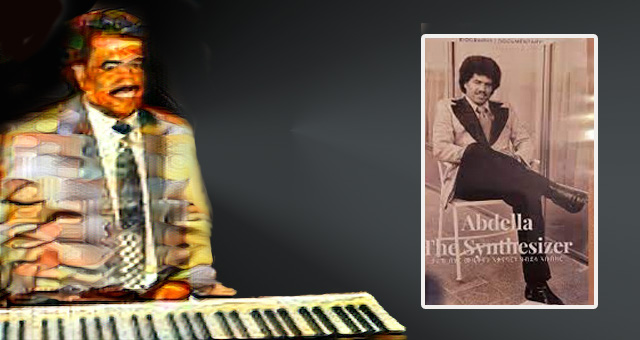The Eritrean keyboard Master: Abdalla Abubakar

Abdalla Abubakar’s towering contribution towards the development of the Eritrean music had not received its due acknowledgement until late. Thanks to the efforts made by Habtom Debessay, there is a documentary released recounting the 50 years of musical life of the legendary Abdallah Abubakar.
The war of liberation was raging and came closer to the environs of Asmara when the Ethiopian atrocities inside Asmara got more vicious mass and youth exodus followed. The top singers fled Asmara leaving behind only memories of their products. But Abdalla was not so much a household name as the famous singers were.
The Echoes of Exile
Once in Saudi Arabia, Abdalla released his first volume of instrumental music. Before the advent of the internet, the release was to connect the fans of pop culture with each other and their old good times in the once culturally vibrant city of Asmara. His first instrumental volume was more than just a treat for the listening pleasure; it also signalled the revival of the pop music in exile. In addition, it was to spread the news that Abdalla had started recording. Vocalists flocked one after another to get their songs recorded in that portable min-studio in Dammam, in Saudi Arabia, to become an Eritrean equivalent of Motown. The keyboard accompaniment in Yemane Ghebremicahel’s “Zemen” was the maiden recording of Abdalla’s unmistakable musical arrangements.
Within the main story line in this video are a couple of amusing anecdotes relating to his dream instrument, the Hammond organ and how Abdalla acquired it. The Hammond organ arrived and when its keyboards came into contact with magical finger they were to make musical marvels.
A fellow Eritrean, in astonishment, on hearing how much Abdallah had to spend on the instrument wonders loud “Couldn’t you have bought a vacuum track (Shefata), a means of lucrative business in those days.
For Abdalla though, money was not everything. Far from being a transactional who first asks what profits him, he was passionate about his accomplishments and senses of fulfilment that this will bring about. His most important motivation, in his own words “after the dispersal in mid-1970s, I started to worry about what was going to happen to our music, on which we had invested so much. So, I thought to at least record and preserve our songs instrumentally”. (Personal communication, April, 2017)
Then Abdalla remembers, one of these days he was moving house, an onlooker says, “the other day I saw you with your ታቦት (Tabernacle) mounted on GMC truck…”
The remark points to that very scene of the iconic instrument covered in black blanket to protect the instrument from collecting dust, analogous to the respect accorded to the Orthodox tabernacle which signifies a typical Eritrean Highland metaphor.
Abdalla, “The synthesizer”
They dubbed him “the Synthesizer”, so the documentary got its title therefrom. Abdalla the musician is a multilingual and multi-talented individual. He is drummer, a singer-songwriter, a record producer, and a music arranger.
According to Tesfamariam an established musician both by training and profession, “Abdallah brought up Eritrean music to certain heights”. By mid 80s, between 70 and 80 pieces were produced that included Haile Ghebru 2 volumes, Hagos Berhane 2 volumes, Sami Berhane, and Abrar Osman’s.
The documentary can be understood as a film on the history of the development of Eritrean pop culture through Abdalla’s story. His narrative interviews take us through his personal journey spanning over fifty years. It is 2:19 hrs video of fascinating lived experience of a versatile artist. The narrative “self” with unique flair of story-telling spiced up with his Asmarite sense of humour make his narration engagingly captivating.
Also, the episodes in the story line are tied up by the fascinating consistency with which a dozen of artists testifying to the hallmarks of Abdalla’s personality traits: kindness, generosity, modesty, honesty and many more human virtues that make up the great Abdalla, not to mention his unparalleled contribution to Eritrean popular music. ( See endnotes, 1)
There are heroes in all walks including musical heroes. A lifelong band-mate Haile Ghebru believes Abdalla’s measure to a “hero”. This coming from his age-old colleague, together with the sincere testimonies of the rest of the trend-setter artists should befittingly characterise him. Haile has more to say about Addalla’s musical ingenuity (1)
Unlike some of his African counterparts, the likes of Mulatu Astakie, who got the opportunity to go to a music school, Abdalla was only self-taught. Inspired by mainly Tewelde Redda, together with Tewolde Abraha, Jaber Mahmud, Asres Tesemma, he became what he was capable of being. His sheer determination and passion paid off; he honed his talents to become the best musical innovator in modern day Eritrea.
Abdalla unapologetically recounts about his parentage in the first 60 seconds of his interview. Born and bred in one of the oldest native neighbourhood, Gheza Berhanu in Asmara, as much as he is a transnational being, in the musical sense, Abdalla epitomizes a cosmopolitan youth of the early 1970s Asmara.
Equally, it is fair to mention that the story matters in that it enlightens our modern conceptions of identity formation, as such a progressive view. It is through the process of “becoming” that we are who we are, instead of solely on the basis of our DNA. He has not only been a patriotic Eritrean through and through but also helped shape the identity of the Eritrean music. This is confirmed by the practical and material support he offered to the EPLF during the period of independence.
Unfortunately, the Eritrean transnational political field is an Orwellian world though where the once a conqueror becomes conquered. Perhaps one cannot but mention what transpired recently in so far as issues of justice are concerned. In this case, the way the hero-like honour the Eritrean-American comedian was given represents a counterpoint to our hero in this saga, in every sense. I will explain about these open political events below (See end notes 2-4)
Indeed, it is a saga of an individual who singlehandedly rose to become the best musical innovator Eritrea had seen. The English subtitles will definitely assist non-native Tigrinya speakers to follow the story of such a phenomenal Eritrean artist. Credit should go to all the people who participated in the project. Obviously this could not have been possible without Habtom Debessay’s commendable efforts from start to end. It is my hope that this valuable film is made available to all his fans sooner than later. Meanwhile, it is my sincere wish and pray for that Abdalla gets over the serious health issue he is currently suffering from.
______________________________________________________________
Endnotes
1 Three decades now, Haile Ghebru came with his lyrics and melody ready-made asking Abdalla for recoding. After studying the lyrics Abdalla asks for Haile’s consent to make changes of the melody to which Haile agrees. Working on it passionately, Abdalla came up with changes and improvisations to make a wonderful composition to match the lyrical content perfectly: It is both pleasantly melancholic and a romantic masterpiece of Tigrinya popular music.
The ጥሽ, the ጤሳ and the ዓሻ
2. The way she fetishized the ጢሽ (a particular kind of traditional smoke treatment or a spa for personal care) can only be described as outlandish.
3. The local authorities in her grandfather’s village of origin made a mockery of both the bizarre religious ritual held in her honour. They had her get Tiesa, the right by birth to own an allotment for house building in one’s native village). This too was undue politicization of the acquisition of land which has nothing to do with spirt of customs and social practices.
4. True to its nature, the PFDJ Orthodox church held a mundane religious ceremony in the service of an individual who is utterly out of touch with cultural norms, not to mention the cultural sense of humour. Hypocrisy at its best was in display.




Awate Forum